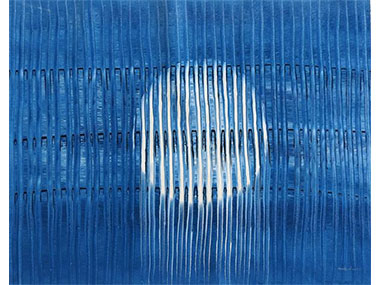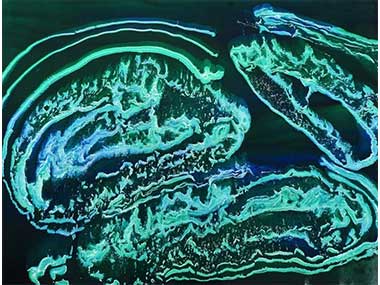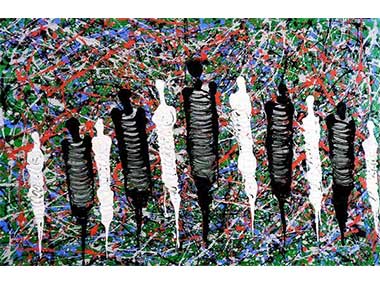THE LOCKHART BRAND IS BUOYED UP

The Lockhart Art Gang's first star, Rosella Namok's 'Full Moon - Early Evening Rise' (2018) using sand beach language
Posted by Jeremy Eccles | 24.05.18
Gallery: Art Atrium
Dates:
23.05.18
: 09.06.18
I've been a fan of the artists from Lockhart River on Cape York for almost 20 years now – ever since a bunch of giggling girls appeared at the International Works on Paper Fair in Sydney in 1999. This mob, calling themselves the 'Lockhart Art Gang', stunned the crowds with their artistic maturity and technical competence – mainly in print-making. Within a few years, they had painting shows in all the southern capitals, appearing in the Wynne Prize, taking their prints to Slovenia's Graphic Arts Biennial, and featuring prominently in the Queensland Art Gallery's first ever acknowledgement of Cape York's re-emerging art activity, Story Place, in 2003.
For the most part, Aboriginal art in any community has emerged from its elders, now finished child-raising or station work, wise in the ways of their tribe and committing that knowledge to canvas while making some money. So it was remarkable that in Lockhart, precisely the opposite happened: it was the kids who were burning to make art (was it an inspiring school art teacher?) though they frequently employed the 'sand beach language' they'd learned from their parents and grandparents in the process.
This basically means illustrating the stories told by elders while sitting around on the beach by drawing lines in the wet sand with their fingers. And this is still the process by which the first Art Gang superstar, Rosella Namok makes her point on canvas in paint. She also explains that her father would paint up bodies of dancers with his fingers when preparing for ceremony.
Not that ceremonial matters have been the main subject of the art in Lockhart. Those old stories that explain and justify their moiety system do come in; but the physical extremes of life in the Far North also appear through storms, fires, and tidal movements on the land, plus reef imagery for peoples who regard fishing as a major source of both food and relaxation.
A little geography and history at this point. Lockhart River is 850 km north of Cairns and is frequently cut off in the wet as there are 20 creeks to cross to get to the main road. It was an Anglican mission set up in 1924 and the thoughtful Queensland government dumped a variety of different Cape tribes there a decade later. With the Japanese threatening, the Europeans were all shipped out during the War – creating an independent Indigenous mindset that allowed them to refuse to move out when the State Government tried to close the community down in 1964. There's now a permanent population of over a thousand.
But remote life has its problems: there were no Lockhart entries for the important Telstra NATSIA Awards this year because lightning took out the community's ageing communications tower for precisely the month when they should have sent in online entries.
The mix of Umpila, Kuuku Ya'u and Lama Lama speakers also doesn't always make for a comfortable community. Samantha Hobson's paintings, for instance, frequently reflect on domestic violence, suicide and alcoholic excess. A significant Patrick Butcher print called Saying Goodbye showed the plane that all-too-often takes young men off to court and prison in Cairns.
So, in the early noughties, artists defected from Lockhart for Cairns, following their founding art centre managers. Some of the fire went out of the Art Gang; less-than-able managers were unable to bring it back.
But you wouldn't know that today when 2017 ended with a big show in Houston, 2018 started with another in Hobart (Art Mob), and this month sees three Lockhart Art exhibitions, including one in Geneva (at Foundation Burkhardt-Felder Arts et Culture), one in Hobart, and another at Sydney's Art Atrium (to be launched this week by Pat Corrigan AM, art collector and philanthropist).
In a big way, the Lockhart River Gang is back – though it now includes Rosella Namok's mother Irene and artists like Queenie Giblet verging on her 80th year, brought into the art-making fold by the success of their kids and grandkids and won over from the weaving they'd traditionally done.
Amazingly, there's enough art left over for a big fund-raising event in Brisbane in June and a presence at both the Cairns Indigenous Art Fair in July and the Darwin Aboriginal Art Fair – where they did $64,000 worth of business last year - in August!
Has it anything to do with Enoch Perazim? This man, who originates from PNG, came into the Lockhart Art Centre in 2014 as its sales manager. He freely admits to not having an art background at all but had clearly improved the red numbers there by 2016 when his predecessor as manager retired. Since then, as the manager himself, he's concentrated on a business plan that depends on good relations with commercial galleries and giving the artists free reign to make the art they want - “as long as it's good quality”, he insists. The three or four outliers in Cairns can continue to have solo shows with galleries they've built relations with, but also happily contribute strongly to the group shows.
So Fiona Omeenyo continues, in her Cairns garage, to paint her father's Miiku and the Parrot Sisters story from Pathaco. In it, Miiku, who'd been promised the Sisters in marriage, was stupidly invited to their wedding to another - Kuchuutu, the sea eagle! In a fury, he danced his rain dance, causing a flood, and then paddled to the wedding ground and stole the sisters away to be hidden in a grass hut on Hay Island. Kuchuutu can today be seen hovering overhead, still looking for his lost wives.
Brother Josiah Omeenyo paints aerial views of the threatened Reef, the elder Irene Namok prefers to reflect on everyday life via brilliant abstraction, Silas Hobson (who managed a solo at KickArts in Cairns in March) seems to be channelling Jackson Pollock and Queenie Giblet goes for delicate dotting. Meanwhile, Lawrence Omeenyo's black and white prints reveal both the influence of the Torres Strait origin of many Lockhart River people and his studies at the Cairns TAFE, which has introduced so many TSI artists to printing.
This freedom of artistic movement in which no 'house style' is imposed (even while the Art Gang brand is reinforced) comes at an interesting time for Aboriginal art. Only last week, the ABC's Radio National 'Earshot' program was in Yuendumu's Warlukurlangu Art Centre to hear just how much more businesslike it's become since I filmed there in the 1990s. Then, every canvas had to have its story fully recorded – which naturally encouraged the artists to concentrate on painting 'important' stories. Now, that's well behind sale-ability in the priorities, even tackling the tourist market through wholesalers like Birubi Art, currently being sued by the ACCC for the false labelling of Aboriginal artefacts.
Enoch Perazim has clearly not gone that far at Lockhart. But there is undoubtedly a positive nexus between selling art around the world, being able to pay artists regularly and their enthusiasm for getting down to business!
Art Atrium's Lockhart River Art Exhibition opened on 23 May with artists Irene Namok and Silas Hobson. The launch with Pat Corrigan AM is set for Saturday 26 May 2018 at 4.00 (to 6.00 pm).
URL: http://artatrium.com.au/lockhart-river-art/
Share this:
»  del.icio.us
»
del.icio.us
»  Digg it
»
Digg it
»  reddit
»
reddit
»  Google
»
Google
»  StumbleUpon
»
StumbleUpon
»  Technorati
»
Technorati
»  Facebook
Facebook
Contact Details
Gallery: Art Atrium
Contact: Simon Chan
Telephone: +61 2 9388 9908
Address: 181 Old South Head Rd Bondi Junction Sydney 2022 NSW
Gallery: Art Atrium
Contact: Simon Chan
Telephone: +61 2 9388 9908
Address: 181 Old South Head Rd Bondi Junction Sydney 2022 NSW

Samantha Hobson's 'Glowing Bright Reef' (2018) showing Lockhart's closeness to the Barrier Reef

Silas Hobson's painting, 'Untitled' (2017) with unconscious reference to the great Jackson Pollock
Where is the exhibition?
Further Research
Gallery: Art Atrium
Artists: Fiona Omeenyo | Irene Namok | Josiah Omeenyo | Lawrence Omeenyo | Patrick Butcher | Queenie Giblet | Rosella Namok | Silas Hobson
News Tags: Art Atrium | CIAF | Enoch Perazim | Jeremy Eccles | Lockhart River Art Gang | NATSIAAs | Warlukurlangu Art Centre
News Categories: Australia | Blog | Europe | Exhibition | Feature | Industry | News
Exhibition Archive
- 24.05.18 | THE LOCKHART BRAND IS BUOYED UP
- 03.05.18 | THE WYNNE'S A WINNER AGAIN
- 02.05.18 | NATSIAA FINALISTS ANNOUNCED
- 07.04.18 | ENGLAND'S EMILY?
- 04.04.18 | THE SONGKEEPERS
- 19.03.18 | ON GADI COUNTRY
- 16.03.18 | SPECIAL REQUEST
- 20.02.18 | Gapu-Monuk – Saltwater Barks
- 16.02.18 | SONGLINES SYMPOSIUM
- 06.02.18 | SONGLINES – TRACKING THE SEVEN SISTERS
- 31.01.18 | Dennis Nona Emerges in Hobart
- 30.11.17 | Great Artists, Great Stories, Limited Time
- 27.11.17 | Moodoonuthi - 'Little One'
- 24.11.17 | 20% Off until End November
- 23.11.17 | THE APY LANDS COME TO SYDNEY
Advertising

